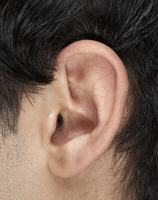Stay Informed
Popular Articles
- Hiatal Hernia: Hidden Cause of Chronic Illness
- Small Intestinal Bacterial Overgrowth (SIBO)
- Applied Lymphology: Unlocking the Secret to Pain Relief
- An Introduction to Constitutional Iridology
- The Low Down on Liver Detoxification
- An Energetic and Emotional Approach to Cancer
- Fat Facts
- Marrow in the Bones
- Blood Type and Nutrition
- Cardiac Herbs: Beyond Hawthorn
Quick Search
The School of Modern Herbal Medicine




How Muscle Tension Affects Hearing and Eyesight
- 12/13/2008
- Categorized in: General Health
This is page 3 of "Relax Your Way to Better Health (and Energy)".
In this section I'll share a couple of practical ways to apply this principle.
Tension and Eyesight
A couple of years ago I bought a book on improving vision naturally. Here's what I learned.
 The lens of your eye is controlled by muscles that contract to help you see things close-up. When those muscles relax, you can see things that are far off. When you do a lot of close-up work such as reading, writing, working at a computer, etc. these muscles have to stay in a contracted state for prolonged periods of time. Eventually, they become fatigued and start to become chronically tense. This makes you nearsighted, meaning you can see things close up, but can't see things far away. Most kids who wear glasses are nearsighted.
The lens of your eye is controlled by muscles that contract to help you see things close-up. When those muscles relax, you can see things that are far off. When you do a lot of close-up work such as reading, writing, working at a computer, etc. these muscles have to stay in a contracted state for prolonged periods of time. Eventually, they become fatigued and start to become chronically tense. This makes you nearsighted, meaning you can see things close up, but can't see things far away. Most kids who wear glasses are nearsighted.
About ten years ago, I started needing bifocals because I was losing my ability to see close-up. This happens as people get older and lose eye muscle tone. Because the muscles that control the lens can't contract as strongly as they used to, the ability to see close-up starts diminishing.
At a lecture on hallucinogenic herbs I attended once, the speaker said that after she participated in a Native American peyote ceremony she was able to throw away her glasses. I now understand why. Peyote, like lobelia and kava, is a strong antispasmodic, meaning it relaxes muscles and relieves cramping. During a peyote ceremony, participants are given peyote over and over again, which will often induce vomiting, sweating and other signs that muscles everywhere are relaxing. If the muscles of the eyes became relaxed enough, the ability to see into the distance would be restored.
Likewise, if I could get in the habit of taking a break from my computer work or reading and go outside every hour to look at far off things (without my glasses, of course), my eyesight would improve. It's not a matter of straining to see better, it's a matter of relaxing to see better.
Here's another application of this information—hearing.
Tension and Ringing in the Ears
A couple of years ago I went to the exhibit "Bodies" in Las Vegas. The exhibit showed real human bodies and organs that h
ad been filled with a special plastic to preserve them. It was fascinating, but also a little bit creepy. Still, I'm glad I went because of what I learned about tinnitis or ringing in the ears.
This condition has long puzzled me. I know that ear infections can cause it. I also know that poor circulation, as in hardening of the arteries, can cause it. But these causes don't account for most cases I've seen. What I learned at the Bodies expo gave me the answer I was looking for.
One of the exhibits showed the tiny bones in the ear—the hammer, anvil, and stirrup. The note beside them explained that these bones, which transmit sound vibrations from the eardrum to the inner ear, are connected to tiny muscles. When we hear loud noises, these muscles contract to lessen the vibrations being transmitted via the bones.
So, when a person has been subjected to loud noises over a long period of time, these muscles become increasingly te
nse. This starts causing some loss of hearing. If the muscles become chronically tense and can't relax, the tension causes a slight “waver” in the muscle tone, which makes the ears ring.
In other words, it's the same problem that causes a person's hands to tremble when they are ennervated from chronic stress. The tense muscles are trying to relax, but can't, so they tremble slightly.
Thus, the problem with ringing in the ears is often due to chronic muscle tension in the muscles within the ears. Again, relaxation is the answer. This may explain why relaxing nervines like lobelia or CBG extract used as ear drops will sometimes help ringing in the ears.
Of course there are other underlying causes of ringing in the ears such as ear infections, nerve damage and poor circulation, so you have to figure out the exact cause of the problem before you can apply the right remedy.

